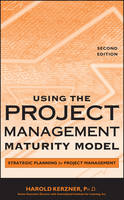Using the Project Management Maturity Model
Using the Project Management Maturity Model
Strategic Planning for Project Management
Kerzner, Harold
John Wiley & Sons Inc
04/2005
352
Dura
Inglês
9780471691617
620
Descrição não disponível.
Foreword. Foreword to the First Edition. Preface. Introduction. 1. The Need for Strategic Planning for Project Management. Introduction. Misconceptions. Wall Street Benefits. Stakeholders. Gap Analysis. Concluding Remarks. 2. Impact of Economic Conditions on Project Management. Introduction. Historical Basis. 3. Principles of Strategic Planning. General Strategic Planning. What Is Strategic Planning for Project Management? Executive Involvement. The General Environment. Critical Success Factors for Strategic Planning. Qualitative Factors. Organizational Factors. Quantitative Factors. Identifying Strategic Resources. Why Does Strategic Planning for Project Management Sometimes Fail? 4. An Introduction to the Project Management Maturity Model (PMMM). Introduction. The Foundation for Excellence. Overlap of Levels. Risks. Assessment Instruments. 5. Level 1: Common Language. Introduction. Roadblocks. Advancement Criteria. Risk. Assessment Instrument for Level 1. Questions. Answer Key. Explanation of Points for Level 1. 6. Level 2: Common Processes. Introduction. Life Cycles for Level 2. Roadblocks. Advancement Criteria. Risk. Overlapping Levels. Assessment Instrument for Level 2. Questions. Explanation of Points for Level 2. 7. Level 3: Singular Methodology. Introduction. Integrated Processes. Culture. Management Support. Informal Project Management. Training and Education. Behavioral Excellence. Roadblocks. Advancement Criteria. Risk. Overlapping Levels. Assessment Instrument for Level 3. Questions. Answer Key. Explanation of Points for Level 3. 8. Level 4: Benchmarking. Introduction. Characteristics. The Project Office/Center of Excellence. Benchmarking Opportunities. Roadblocks. Advancement Criteria. Assessment Instrument for Level 4. Questions. Explanation of Points for Level 4. 9. Level 5: Continuous Improvement. Characteristics. Continuous Improvement Areas. The Never-Ending Cycle. Examples of Continuous Improvement. Developing Effective Procedural Documentation. Project Management Methodologies. Continuous Improvement. Capacity Planning. Competency Models. Managing Multiple Projects. End-of-Phase Review Meetings. Strategic Selection of Projects. Portfolio Selection of Projects. Horizontal or Project Accounting. Organizational Restructuring. Career Planning. Assessment Instrument for Level 5. Questions. Explanation of Points for Level 5. 10. Sustainable Competitive Advantage. Introduction. Strategic Thrusts. The Need for Continuous Improvement. Project Management Competitiveness. Products versus Solutions. Enterprise Project Management. Engagement Project Management. 11. Special Problems with Strategic Planning for Project Management. Introduction. The Many Faces of Success. The Many Faces of Failure. Training and Education. Cultural Change Management. Partnerships. The Impact of Risk Control Measures. Dependencies between Risks. Selecting the Appropriate Response Mechanism. Conclusions. 12. The Project Office. Introduction. The Project Office: 1950-1990. The Project Office: 1990-2000. The Project Office: 2000-Present. Types of Project Offices. Project Management Information Systems. Dissemination of Information. Mentoring. Development of Standards and Templates. Project Management Benchmarking. Business Case Development. Customized Training (Related to Project Management). Managing Stakeholders. Continuous Improvement. Capacity Planning. Risks of Using a Project Office, Reporting and Structure. Reporting and Structure. 13. Six Sigma and the Project Management Office. Introduction. Traditional versus Nontraditional Six Sigma. Understanding Six Sigma. Six Sigma Myths. Use of Assessments. Project Selection. Typical PMO Six Sigma Projects. 14. How to Conduct a Project Management Maturity Assessment. Introduction. Find Ways to Bypass the Corporate Immune System. Explain Why You Are Doing This. Pick the Model That Is Best for Your Organization. Maturity Models: How Do They Compare? Create the Right Fit. Choose an Appropriate Delivery Method. Establish Responsibility. Decide Who Should Participate. Turn the Results into an Action Plan. Develop a Remedial Training Curriculum. Keep Top Management Informed. Virtual Reporting. Benchmark Your Results to Others. Do It Again. 15. Understanding Best Practices. Introduction. What to Do with a Best Practice. Critical Questions. Levels of Best Practices. Common Beliefs. The Best Practices Library. Case Studies. Case 1: Packer Telecom. Case 2: Luxor Technologies. Case 3: Altex Corporation. Case 4: Acme Corporation. Case 5: Quantum Telecom. Case 6: Lakes Automotive. Case 7: Ferris HealthCare, Inc. Case 8: Clark Faucet Company. Case 9: Hyten Corporation. Case 10: Como Tool and Die (A). Case 11: Como Tool and Die (B). Case 12: Macon Inc. Case 13: The Trophy Project. Case 14: The Blue Spider Project. Case 15: Corwin Corporation. Case 16: MIS Project Management at First National Bank. Index.
Este título pertence ao(s) assunto(s) indicados(s). Para ver outros títulos clique no assunto desejado.
PMI; PMBOK; PMP; Kerzner
Foreword. Foreword to the First Edition. Preface. Introduction. 1. The Need for Strategic Planning for Project Management. Introduction. Misconceptions. Wall Street Benefits. Stakeholders. Gap Analysis. Concluding Remarks. 2. Impact of Economic Conditions on Project Management. Introduction. Historical Basis. 3. Principles of Strategic Planning. General Strategic Planning. What Is Strategic Planning for Project Management? Executive Involvement. The General Environment. Critical Success Factors for Strategic Planning. Qualitative Factors. Organizational Factors. Quantitative Factors. Identifying Strategic Resources. Why Does Strategic Planning for Project Management Sometimes Fail? 4. An Introduction to the Project Management Maturity Model (PMMM). Introduction. The Foundation for Excellence. Overlap of Levels. Risks. Assessment Instruments. 5. Level 1: Common Language. Introduction. Roadblocks. Advancement Criteria. Risk. Assessment Instrument for Level 1. Questions. Answer Key. Explanation of Points for Level 1. 6. Level 2: Common Processes. Introduction. Life Cycles for Level 2. Roadblocks. Advancement Criteria. Risk. Overlapping Levels. Assessment Instrument for Level 2. Questions. Explanation of Points for Level 2. 7. Level 3: Singular Methodology. Introduction. Integrated Processes. Culture. Management Support. Informal Project Management. Training and Education. Behavioral Excellence. Roadblocks. Advancement Criteria. Risk. Overlapping Levels. Assessment Instrument for Level 3. Questions. Answer Key. Explanation of Points for Level 3. 8. Level 4: Benchmarking. Introduction. Characteristics. The Project Office/Center of Excellence. Benchmarking Opportunities. Roadblocks. Advancement Criteria. Assessment Instrument for Level 4. Questions. Explanation of Points for Level 4. 9. Level 5: Continuous Improvement. Characteristics. Continuous Improvement Areas. The Never-Ending Cycle. Examples of Continuous Improvement. Developing Effective Procedural Documentation. Project Management Methodologies. Continuous Improvement. Capacity Planning. Competency Models. Managing Multiple Projects. End-of-Phase Review Meetings. Strategic Selection of Projects. Portfolio Selection of Projects. Horizontal or Project Accounting. Organizational Restructuring. Career Planning. Assessment Instrument for Level 5. Questions. Explanation of Points for Level 5. 10. Sustainable Competitive Advantage. Introduction. Strategic Thrusts. The Need for Continuous Improvement. Project Management Competitiveness. Products versus Solutions. Enterprise Project Management. Engagement Project Management. 11. Special Problems with Strategic Planning for Project Management. Introduction. The Many Faces of Success. The Many Faces of Failure. Training and Education. Cultural Change Management. Partnerships. The Impact of Risk Control Measures. Dependencies between Risks. Selecting the Appropriate Response Mechanism. Conclusions. 12. The Project Office. Introduction. The Project Office: 1950-1990. The Project Office: 1990-2000. The Project Office: 2000-Present. Types of Project Offices. Project Management Information Systems. Dissemination of Information. Mentoring. Development of Standards and Templates. Project Management Benchmarking. Business Case Development. Customized Training (Related to Project Management). Managing Stakeholders. Continuous Improvement. Capacity Planning. Risks of Using a Project Office, Reporting and Structure. Reporting and Structure. 13. Six Sigma and the Project Management Office. Introduction. Traditional versus Nontraditional Six Sigma. Understanding Six Sigma. Six Sigma Myths. Use of Assessments. Project Selection. Typical PMO Six Sigma Projects. 14. How to Conduct a Project Management Maturity Assessment. Introduction. Find Ways to Bypass the Corporate Immune System. Explain Why You Are Doing This. Pick the Model That Is Best for Your Organization. Maturity Models: How Do They Compare? Create the Right Fit. Choose an Appropriate Delivery Method. Establish Responsibility. Decide Who Should Participate. Turn the Results into an Action Plan. Develop a Remedial Training Curriculum. Keep Top Management Informed. Virtual Reporting. Benchmark Your Results to Others. Do It Again. 15. Understanding Best Practices. Introduction. What to Do with a Best Practice. Critical Questions. Levels of Best Practices. Common Beliefs. The Best Practices Library. Case Studies. Case 1: Packer Telecom. Case 2: Luxor Technologies. Case 3: Altex Corporation. Case 4: Acme Corporation. Case 5: Quantum Telecom. Case 6: Lakes Automotive. Case 7: Ferris HealthCare, Inc. Case 8: Clark Faucet Company. Case 9: Hyten Corporation. Case 10: Como Tool and Die (A). Case 11: Como Tool and Die (B). Case 12: Macon Inc. Case 13: The Trophy Project. Case 14: The Blue Spider Project. Case 15: Corwin Corporation. Case 16: MIS Project Management at First National Bank. Index.
Este título pertence ao(s) assunto(s) indicados(s). Para ver outros títulos clique no assunto desejado.





